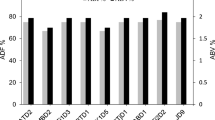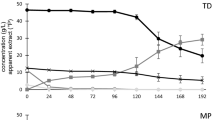Abstract
High-gravity brewing, which can decrease production costs by increasing brewery yields, has become an attractive alternative to traditional brewing methods. However, as higher sugar concentration is required, the yeast is exposed to various stresses during fermentation. We evaluated the influence of high-gravity brewing on the fermentation performance of the brewer’s yeast under model brewing conditions. The lager brewer’s strain Weihenstephan 34/70 strain was characterized at three different gravities by adding either glucose or maltose syrups to the basic wort. We observed that increased gravity resulted in a lower specific growth rate, a longer lag phase before initiation of ethanol production, incomplete sugar utilization, and an increase in the concentrations of ethyl acetate and isoamyl acetate in the final beer. Increasing the gravity by adding maltose syrup as opposed to glucose syrup resulted in more balanced fermentation performance in terms of higher cell numbers, respectively, higher wort fermentability and a more favorable flavor profile of the final beer. Our study underlines the effects of the various stress factors on brewer’s yeast metabolism and the influence of the type of sugar syrups on the fermentation performance and the flavor profile of the final beer.



Similar content being viewed by others
References
Beney L, Marechal P, Gervais P (2001) Coupling effects of osmotic pressure and temperature on the viability of Saccharomyces cerevisiae. Appl Microbiol Biotechnol 56:513–516
Blieck L, Toye G, Dumortier F, Verstrepen K, Delvaux F, Thevelein J, Van Dijck P (2007) Isolation and characterization of brewer’s yeast variants with improved fermentation performance under high-gravity conditions. Appl Environ Microbiol 73:815–824
Boulton C, Quain D (2006) Brewing yeast and fermentation. Blackwell Science, Oxford
Briggs D, Boulton C, Brookes P, Stevens R (2004) Brewing science and practice. Woodhead, Cambridge
Casey G, Chen E, Ingledew W (1985) High gravity brewing: production of high levels of ethanol without excessive concentrations of esters and fusel alcohols. J Am Soc Brew Chem 43:179–182
De Rouck G, De Clippeleer J, Poiz S, De Cock J, van Waesberghe J, De Cooman L, Aerts G (2007) Prolonged flavor stability by production of beer with low residual FAN using active dry yeast. Proc 31st Congr Eur Brew Conv,Venice
Dietvorst J, Blieck L, Brandt R, Van Dijck P, Steensma H (2007) Attachment of MAL32-encoded maltase on the outside of yeast cells improved matotriose utilisation. Yeast 24:27–32
Dragone G, Mussatto S, Almeida e Silva J (2007) High gravity brewing by continuous process using immobilized yeast: effect of wort original gravity on fermentation performance. J Inst Brew 113:391–398
European Brewery Convention (1992) EBC analytica microbiologica. Fachverlag Hans Carl, Nürnberg
European Brewery Convention (1998) Analytica-EBC. Fachverlag Hans Carl, Nürnberg
Herbert P, Santos L, Alves A (2001) Simultaneous quantification of primary, secondary amino acids, and biogenic amines in musts and wines using OPA/3-MPA/FMOC-Cl fluorescent derivatives. J Food Sci 66:1319–1325
Klein C, Olsson L, Nielsen J (1998) Glucose control in Saccharomyces cerevisiae: the role of MIG1 in metabolic functions. Microbiology 144:13–24
Lekkas C, Stewart G, Hill A, Taidi B, Hodgson J (2007) Elucidation of the role of nitrogenous wort components in yeast fermentation. J Inst Brew 113:3–8
Lillie S, Pringle J (1980) Reserve carbohydrate metabolism in Saccharomyces cerevisiae: responses to nutrient limitation. J Bacteriol 143:1384–1394
Majara M, O’Connor-Cox E, Axcell B (1996) Trehalose- an osmoprotectant and stress indicator compound in high and very high gravity brewing. J Am Soc Brew Chem 54:149–154
Pierce J (1987) Horace Brown Memorial Lecture: the role of nitrogen in brewing. J Inst Brew 93:378–381
Pratt P, Bryce J, Sweart G (2003) The effect of osmotic pressure and ethanol on yeast viability and morphology. J Inst Brew 109:213–228
Rautio J, Londesborough J (2003) Maltose transport by brewer’s yeasts in brewer’s wort. J Inst Brew 109:251–261
Saerens S, Delvaux F, Verstrepen K, Van Dijck P, Thevelein J, Delvaux F (2008) Parameters affecting ethyl ester production by Saccharomyces serevisiae during fermentation. Appl Environ Microbiol 74:454–461
Schulze U, Larsen M, Villadsen J (1995) Determination of intracellular trehalose and glycogen in Saccharomyces cerevisiae. Anal Biochem 228:143–145
Shindo S, Murakani J, Koshino S (1992) Control of acetate ester formation during alcohol fermentation with immobilized yeast. J Ferm Bioeng 73:370–374
Stewart G (1999) High gravity brewing. Brew Guard 128:31–37
Stewart G (2007a) High gravity brewing- the pros and cons. New Food 1:42–46
Stewart G (2007b) The influence of high gravity wort on the stress characteristics of brewer’s yeast and related strains. Cerevisia 32:37–48
Stewart G, D’Amore T, Panchal C, Russel I (1988) Factors that influence the ethanol tolerance of brewer’s yeast strains during high gravity wort fermentations. Tech Q- Master Brew Assoc Am 25:47–53
Wang S, Brandriss M (1987) Proline utilization in Saccharomyces cerevisiae: sequence, regulation, and mitochondrial localization of the PUT1 gene product. Mol Cell Biol 7:4431–4440
Younis O, Stewart G (1998) Sugar uptake and subsequent ester and higher alcohol production by Saccharomyces cerevisiae. J Inst Brew 104:255–264
Acknowledgments
M. P. Piddocke acknowledges FOOD research school at the Center for Advanced Food Studies, Denmark and Novozymes A/S for the awarded scholarships. The authors thank Lise Schultz and Preben Andersen from the Brewing and Alcoholic Beverage Department at Novozymes A/S for the assisted help for the amino acid and free amino nitrogen analyses.
Author information
Authors and Affiliations
Corresponding author
Rights and permissions
About this article
Cite this article
Piddocke, M.P., Kreisz, S., Heldt-Hansen, H.P. et al. Physiological characterization of brewer’s yeast in high-gravity beer fermentations with glucose or maltose syrups as adjuncts. Appl Microbiol Biotechnol 84, 453–464 (2009). https://doi.org/10.1007/s00253-009-1930-y
Received:
Revised:
Accepted:
Published:
Issue Date:
DOI: https://doi.org/10.1007/s00253-009-1930-y




